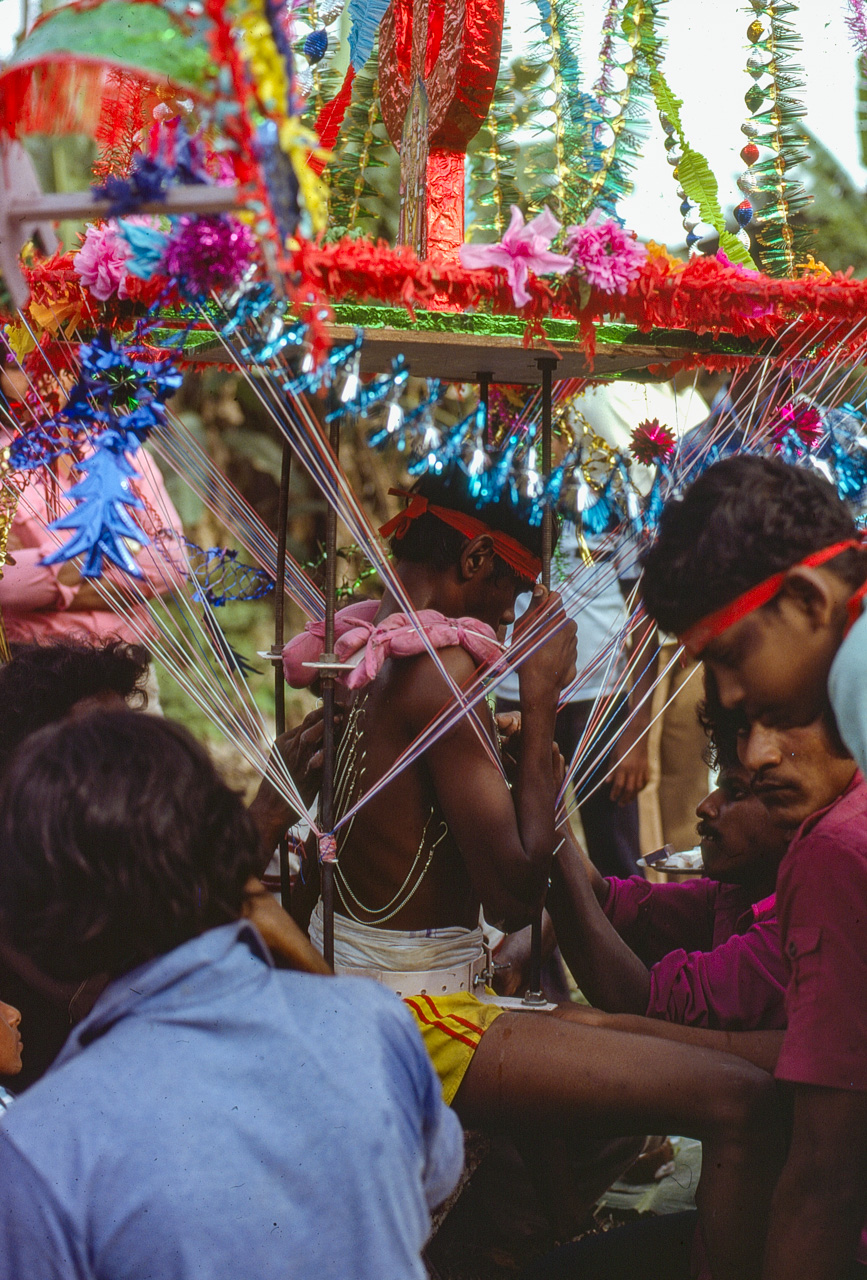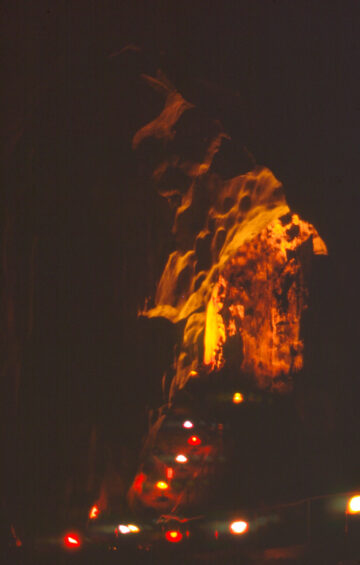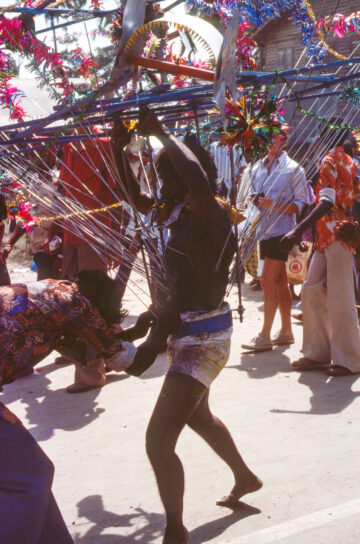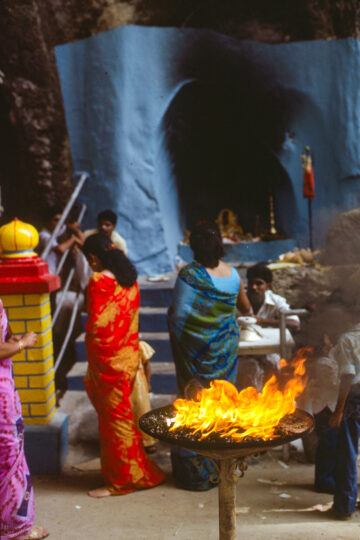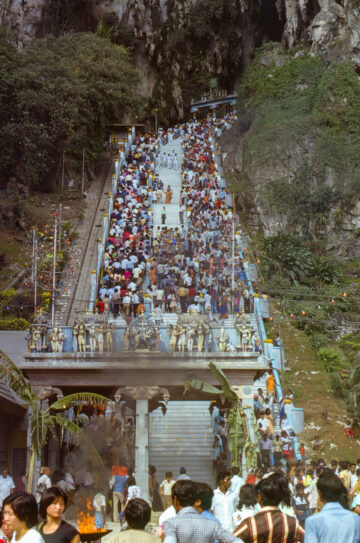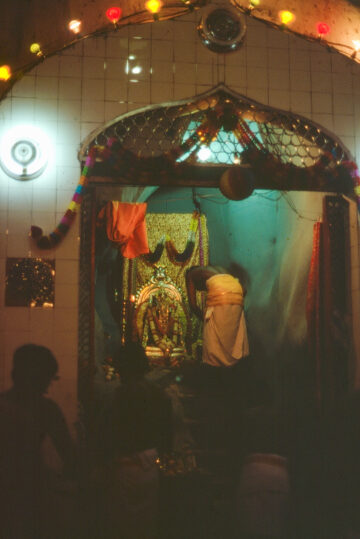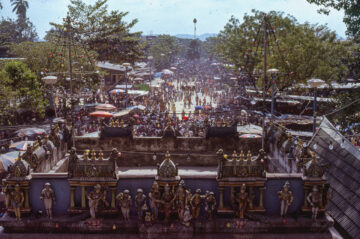My curiosity reached its greatest height as the small Universiti of Malaya bus bounced along with the masses of other vehicles making their way to the Batu Caves. I had heard so many stories of the great Hindu festival of Thaipusam.
I did not know exactly what to expect.
The number of buses, cars and motorbikes multiplied to great numbers and the speed at which we travelled diminished the closer we got to the Batu Caves, eight miles north of Malaysia’s capital city of Kuala Lumpur.
The huge limestone outcroppings of the caves suddenly came into view. It appeared as if they were just randomly dropped amongst the tin mines just for the occasion. As the bus drew closer, the caves and their vicinity came to life as thousands of people pushed and shoved to make their pilgrimage to the caves.
I got off the bus and was quickly sucked up by the flowing masses. I felt a bit out of place among all the Hindu Indians. The women were especially beautiful today. The colors of their finest saris changed the dull and dirty background into a comely and lively setting. Their thick dark hair was neatly managed and glistened in the hot, afternoon sun. The handsome Indian men wore white shirts which contrasted with their dark complexion. I immediately fell in step and began the march to the caves.
***
Thaipusam is rapidly becoming the most popular Hindu festival in Malayasia. It is a time of penitence and thanksgiving for thousands of Hindus. Each year virtually every Hindu living near Kuala Lumpur makes a pilgrimage to the Batu Caves during the festival.
The origin of Thaipusam is woven around many myths. Most of the myths are connected with Shiva, the god of destruction and regeneration and his son Subramanya.
One stories suggests that the son of a rishi (hermit) living in the Himalayas was advised by his father that the worship of Shiva in the form of the dancing Nataraja at Thillai (Chidambaram) in the southern part of India was the most rewarding spiritual exercise for an individual. The youth travelled to Chidambaram and saw Lord Shiva not as Nataraja, but in the lingam form, a phallic symbol. He worshipped this figure with great devotion. After some time he had a great desire to see the vision of Nataraja and beseeched God to reveal this form. The Lord promised to fulfill this desire on Thaipusam day which he did and thereafter this festival is celebrated with grandeur in all Shiva and Subramanya temples.
Another tale relates to the birth of Lord Subramanya, the Son of Shiva. Shiva ceased to be a war leader in order to live a life of penance and austerity and left the gods leaderless. Immediately the gods began to fare badly in their battle with the asuras and an asura leader, Taraka rose to power.
The gods sought the advice of Brahma, the creator, who said that when Shiva married and had a son, the son would destroy Taraka. The gods were cunning and with the help of Kama, the god of love, seduced Shiva to the charms of Parvati, the beautiful daughter of the Himalayas. They were married and gave birth to a handsome baby boy.
When the boy grew into manhood, his mother presented him the invincible javelin (vel) and he went into battle and killed Taraka. The Velis is a spear with a broad head shaped like a heart. The broad head denotes purity of the heart while the sharp end symbolizes closeness to God. The Vel indicates victory, bravery and knowledge. According to tradition, the Vel was bestowed to Subramanya on Thaipusam day.
Determining the date for Thaipusam is a job for the Hindu astronomers. A combination of influences exerted by the signs of the Zodiac, planets, and stars that are ascendant into 12 sections similar to the Greek division but having different names. There is also a lunar Zodiac divided into 27 sections called Nakshatras of asterisms. These are groups of stars recognized by ancient Hindu astronomers as lunar mansions or stations through which the moon passes. Hindus recognize nine planets in all, each exerting its influence in the course of the year. Some planets are a good influence, others are malevolent. The festival of Thaipusam falls on the day on which the asterism Poosam is rising in the month of Thai. This is usually in late January according to the Christian calendar. The presiding deity of this star is the planet Jupiter. Jupiter is a beneficent influence and among the luckiest of the planets. Consequently worship offered on this day would bring special merit to the worshipper.
***
“Hey, Joe! You want cold drink?” The street hawkers were plentiful. The dust, thick from the trampling of all the people, coated my mouth and stuck to my skin. The sun showed no mercy on me, and I was soon sweating profusely. My throat was dry, and I could have used a cold drink, but my curiosity compelled me to keep going onward. I was amazed at the hordes of people and shocked when I heard there were more people here the night before.
***
The festival generally lasts for three days. I was visiting on the second day. On the first day, the statue of Subramanya, decorated with expensive jewels and finery and accompanied by statues of his wives Valli and Theivani is set on a tall chariot and drawn to Batu Caves by bullocks.
The chariot is a huge work of art made out of carved wood, plated over with silver and decorated with gods, goddesses and animals. At dawn, worshippers congregate at the temple in Kuala Lumpur to perform rituals. After the rituals, the procession begins. Worshippers rush out into the streets in frenzied vigor, almost in a trance, and smash coconuts on the road in fulfillment of their vows. The early morning silence is broken by the sound of flutes and drums. The procession picks up momentum and hundreds of chanting and singing Hindus join in. They shout “vel, vel, vetri-vel” in honor of the weapon used by their Lord. Once the statue reaches the foot of Batu Caves it is lifted out of the chariot and carried up the stairs into the caves.
***
There were howls and shouts from people crowding around a circle in front of me. I fought my way into the circle and found out what the commotion was all about. My heart began to throb, and adrenalin rushed through my body. Here before me was the much heard about kavadi carrier.
The young Indian lad had a glassy stare on his face that penetrated deep into my soul. He was surrounded by friends and family. On his shoulders was a gaily decorated kavadi, a great wooden structure. The tension mounted and the devotee and his followers began their trek to the shrine of Lord Subramanya or also known as Lord Murugan.
The modes of devotion for Thaipusam are many and varied. The most extreme form is carrying the kavadi, which is a popular form of penance for Subramanya. It is done in fulfillment of a vow that the devotee has taken in furtherance of some desired objective in his life or as compensation for the avoidance of some calamity.
The carrying of the kavadi culminates a period ranging from 14 to 48 days of strict abstinence and meditation. The devotee must prepare himself spiritually and purify himself by living on a strict vegetarian diet, refraining from smoking and drinking, and avoiding physical pleasures. These rules must be followed strictly or else the consequences will be quite painful.
The kavadi is a wooden arch on a wooden base decorated with peacock feathers and paper and is carried on the shoulders. The kavadi contains a picture of a deity, usually Murugan, and an offering for the god. There are various types of kavadi depending on what kind of offering is made.
The milk kavadi, rose water kavadi, coconut kavadi, and sugar cane kavadi (for sterile women) are some examples.
Hindu mythology accounts for the origin of the kavadi. There was a sage, Agastiyar, who wanted two mountain peaks to meditate upon. Agastiyar summoned his disciple, Idumban, to bring him the two peaks.
The peaks were in an area where Lord Shiva resided. Idumban placed each peak on his shoulders and began his journey home. Lord Murugan, who desired the peaks himself, decided to play a trick. He appeared as a king and asked Idumban to rest from his tiring task. Idumban obeyed and placed the peaks down.
The clever Murugan next took the form of a small boy and stood atop the peaks. Even after his rest, Idumban could not lift the peaks. The little boy claimed possession of the peaks which caused Idumban to argue. Murugan put down his opposition and pushed him off the peak where Ibumban fell unconscious.
Agastiyar searched for his disciple and found him unconscious. He and Idumban’s wife begged the boy for mercy. The Lord now appeared in his own form and saved Idumban and made him his guard. The Lord then declared that he who comes to worship him carrying the kavadi will be blessed. The kavadi can then be looked upon as a semi-chariot in which the devotee carries God upon his shoulders and performs his religious duties during Thaipusam.
***
I made my way to the river where the kavadi bearer’s journey began.
Spectators were silent and spellbound as the devotees were preparing themselves. The devotees bathe in the river to purify themselves, then put their lives into the hands of the guru. I crept down and sat close to the guru and devotee. A small boy who was a part of the group saw me as I reached for my camera and motioned to his friends to clear the path so I could get a clear photo of the devotee. The devotee sat on a stool and did not flinch an eye as the guru stuck hooks through the skin of his back and chest.
Other devotees beside the kavadi carriers were also being prepared.
After frantic dancing one devotee fell to his knees and screamed a frightening howl. Ashes were spread on his forehead and a piece of burning camphor was placed on his tongue which he swallowed to drive out evil spirits. The guru gently placed his fingers on the exhausted devotee’s temples, muttered some words and put the devotee in a trance. A long silver vel about six feet long and one-half inch thick was brought out. One end was sharpened to a point, the other in the three-pointed trident. A lime was slid along the vel. There was silence among the small group of onlookers, all eyes were focused on the devotees cheeks as the tenseness mounted. A friend held the devotee’s head firmly, while the guru took the vel and brought the point to the devotee’s cheek and proceeded to push slowly and firmly until the vel had gone clean through both cheeks and held freely in place. There was a shout from the friends. I stared at the devotee in disbelief and felt my own cheeks and imagined them being punctured. I felt a bit queasy; fortunately, I was sitting down.
I followed the troupe during their long, dusty and hot march. Each troupe consists of a leader with a whip to drive away black magicians, drum players to keep the trance and a host of family and friends to attend to the devotees.
The kavadi carrier stopped several times to rest and have his thirst quenched. I watched closely as the devotee sat on a stool and had a soda poured through his lips. He wore only shorts and his body was small, but in good physical condition. His chest rose with each breath and with a blank look on his face he stared down the road. I watched and admired this brave and devoted young man and pondered about what kind of people would do such an act. Later I had an opportunity to speak to two such people.
***
“I am an ordinary human being.” Dennis sat at the edge of his chair and spoke with great vehemence. Dennis could easily be described as a religious fanatic; he has devoted his life to God.
Dennis may claim he is an ordinary person – superficially he is – but anyone who listens to him speak about religion would find it difficult to consider him typical. Dennis, at age 25, has no job. Instead of working he would rather search for God and perfect himself. He claims his friends and family support him. “I only need 30 sen (13 U.S. cents) a day.” What for? “A pack of cigarettes.” In return for the support by his family and friends, he gives love, friendship and blessings.
Dennis has lived a life full of experiences which he is now ashamed to talk about. He admits that at one time he was a heavy user of marijuana and heroin. Although Dennis is a Hindu, he does not believe in any religion, only in God himself. To him, customs and rituals are manmade and are unnecessary.
Yet he practices them to satisfy his fellow man. Dennis has participated in Thaipusam for many years, but always for someone else. He has carried the whip and pierced his tongue with hooks. The Thaipusam ceremony puts him in a state of ecstasy that makes him dance with vigor. Dennis, as well as all devotees, claims to feel no pain, shed no blood and show no scars as a result of his ordeal. He claims the trance is the reason.
When in the trance the body tightens up. Every muscle contracts and stiffens, which is probably the answer for no bleeding. The devotee is sacrificing his body no God since it is the body not the soul that makes you sin.
What is in Dennis’s future? Next year he would like to go through the festival for himself if God allows it. His fate is totally up to God, he believes, but his goal is “to seek closer contact to God” and become an angel in heaven.
***
Zaivier spoke softly about Thaipusam and carefully chose his English words. His face looked small due to the bushy sideburns, moustache, goatee beard and Afro-style haircut. He is 21, tall, lean and with an athletic build.
Education holds the key to Zavier’s life. He has finished the sixth form (roughly equivalent to high school) and is now waiting for results from his pre-university test. His ambition is to study economics at a university.
It was education that led Zaivier to Thaipusam. He had taken a entrance examination and failed. He was heartbroken, but his elder sister convinced him that if he would pray to God, he could do better. He prayed and the second time he took the examination he passed. To show his thankfulness to the Lord, he carried the milk kavadi for three years.
Although Zaivier is an Indian, he is not a Hindu but a Christian. Like Dennis he does not distinguish between a Hindu God and a Christian God. God is God and he wanted to show his thanks. Thaipusam provided the best means for it. There are frequently men and women of many races and religions that participate in Thaipusam each year.
***
The devotee rose from his stool and began to dance with new strength. I continued to follow him. Suddenly, I heard screams. I watched a man in a frenzied trance pull out his tongue and jab two skewers through it as he screamed a deafening howl. My knees began to weaken at the sight of this.
All around me were sights and sounds that left my heart thumping wildly from the excitement. Sweat rolled down my face and stung my eyes. I was so fascinated by what was occurring that I felt that I was also in a trance and felt no fatigue. The drums continued beating, the people continued chanting, and the devotees continued dancing. I wanted to be a part of the troupe, my heart filled with joy and my legs filled with vigor.
Finally we reached the last obstacle before the shrine of Lord Murugan; the 272 stairs leading to the cave’s entrance. We all took a rest here to renew our strength before the climb. I looked ap at the stairs; it looked like a huge white river of people flowing up and down.
***
Those who want to worship Lord Murugan must climb to him. The deity Narada wanted to test the sons of Shiva; Ganesha and Murugan. Narada offered a golden apple to the first who could go around the world. Murugan immediately mounted his peacock and flew off. Ganesha, the god of learning, displayed his knowledge by asking Narada “What is the difference between the world and one’s parents?” Narada answered there was no difference and there was no greater world than one’s parents.
The wise Ganesha then walked around his parents three times saying “My parents are my world and I go around them.” This was sufficient for Narada, and he gave Ganesha the golden apple.
When the tired Murugan returned and heard what had happened, he flew atop a hill and refused to return. Therefore those who wanted to worship him had to climb up.
***
And climb we did. The stairs were cluttered with shoes. Once you started up the stairs there was no turning back — the mob kept you going. I reached the top before the kavadi carrier and began to explore the cave.
Inside the cave I was flanked by two rows of beggars. I saw a mass of thin, dark arms reach out to me with pale palms outstretched. Gone were the elegant saris and white shirts I had seen below. I found it difficult to pass these poor creatures in the dark cave. Yet I continued and as I did a small Indian girl approached me. She did not speak, she did not have to. I could see it in her eyes. She pressed her palm to me and glared at me with her dark and beautiful eyes. I shook my head and moved on. She ran after me and again thrust out her hand. I dug deep into my pocket and gave her a coin. I walked by the rest of the beggars as they carefully stacked their one sen pieces.
I saw many people gathering toward the far end of the cave. Here was the shrine of Lord Murugan. It marked the end for the long march of the devotees. They dismount their kavadi, present their offering to the deity and are brought out of their trance. A deep feeling of satisfaction overcomes them as they now feel much closer to their god. One devotee screamed and lost control of himself when he was brought out of his trance. Others act naturally and think only of the food which they have abstained from.
The majority of worshippers climb the stairs and get a vision of the deity. The worshipper breaks a coconut and prays before the shrine for some time. He also receives a special ritual performed on his behalf by the officiating priest invoking god’s blessings. At the end of this he receives some objects made sacred from the ritual such as a half a coconut, some flowers, saffron and holy ash which he takes home.
Satisfied that I had seen everything, I walked down the stairs to view the attractions I had missed. In complete contrast to the religious mood I had just witnessed, I now felt the atmosphere of a state fair.
A man shouted in three languages over a P.A. system, an ice cream salesmen counted his profit, and children were having a joyous time on a Ferris wheel. The five acres of land in front of the caves was full of hawkers selling everything imaginable. A large sign lured me to register to win a return ticket to Madras, India. I walked throughout the area, my dust covered feet kicking through the carpet of litter.
The smell of pisang goreng (fried banana) filled the air and whetted my appetite. An Indian man and his family were busy preparing the bananas. The stall looked dirty, but I was hungry and purchased one. As I reached for my money a beggar wasted no time and handed me a piece of paper stating in several languages that he was poor and needed money. By giving him money I knew he would then look to tourists for his livelihood. I handed the paper back to him and ate my banana; it was cold and tasteless.
I realized several hours had slipped by and my bus was due to leave.
Reluctantly, I left the fairgrounds and walked toward the bus. As I waited for the ride back, I stopped at a stall for a drink. The Chinese owner stuck a stalk of sugar cane through what looked like a clothes wringer and produced a foamy, green juice.
I stared out into the multitudes of people and sipped the cool, refreshing nectar. The next day the chariot would return to the temple, the people would return to their homes, the dust would settle, the scars would begin to heal and thoughts would turn to next year’s Thaipusam.
[NOTE: I wrote this story in May 1978 as a part of an independent writing course in university. I have resisted the urge to edit and re-write it and instead have left it in its original form simply as a record to show my evolution as a writer.]

